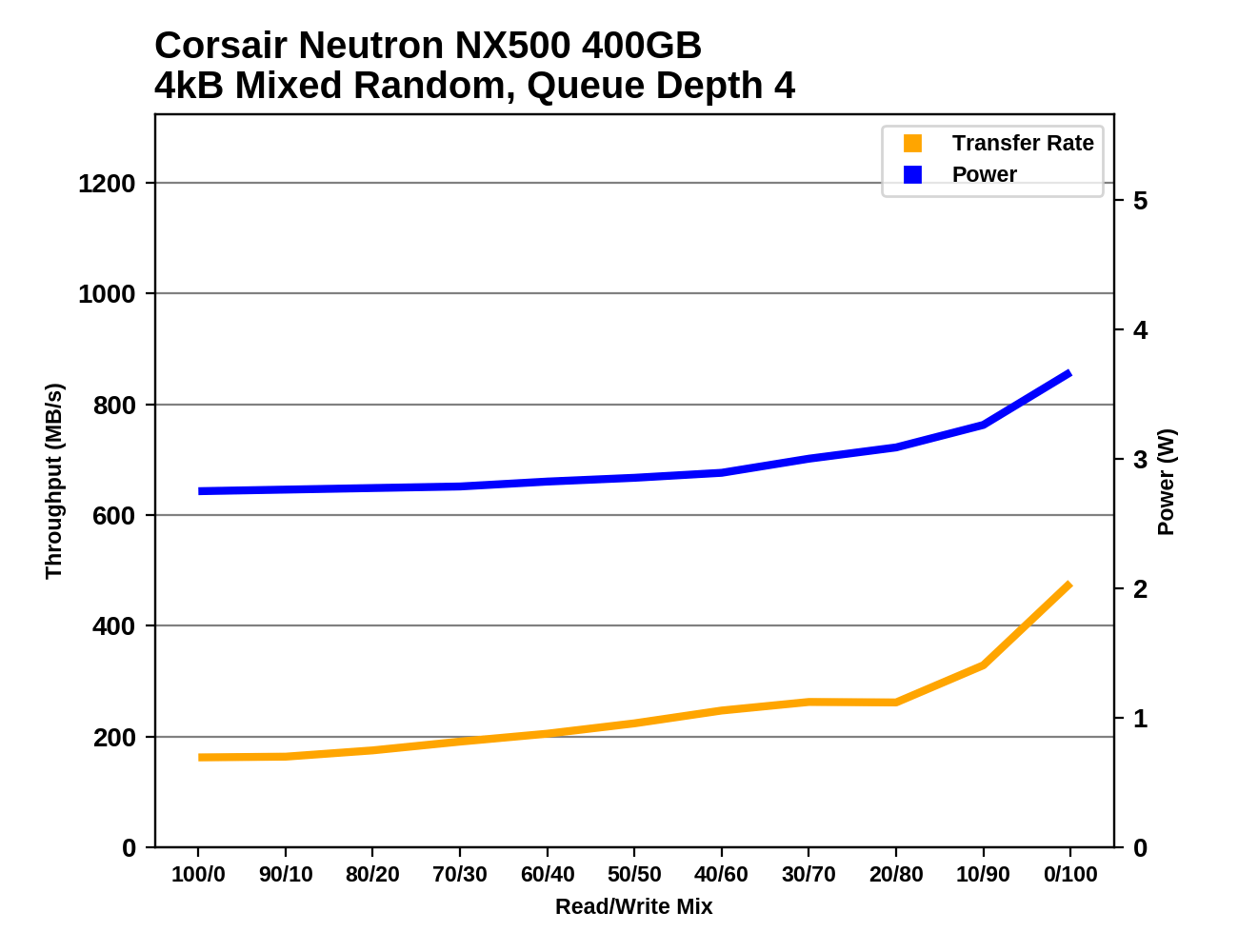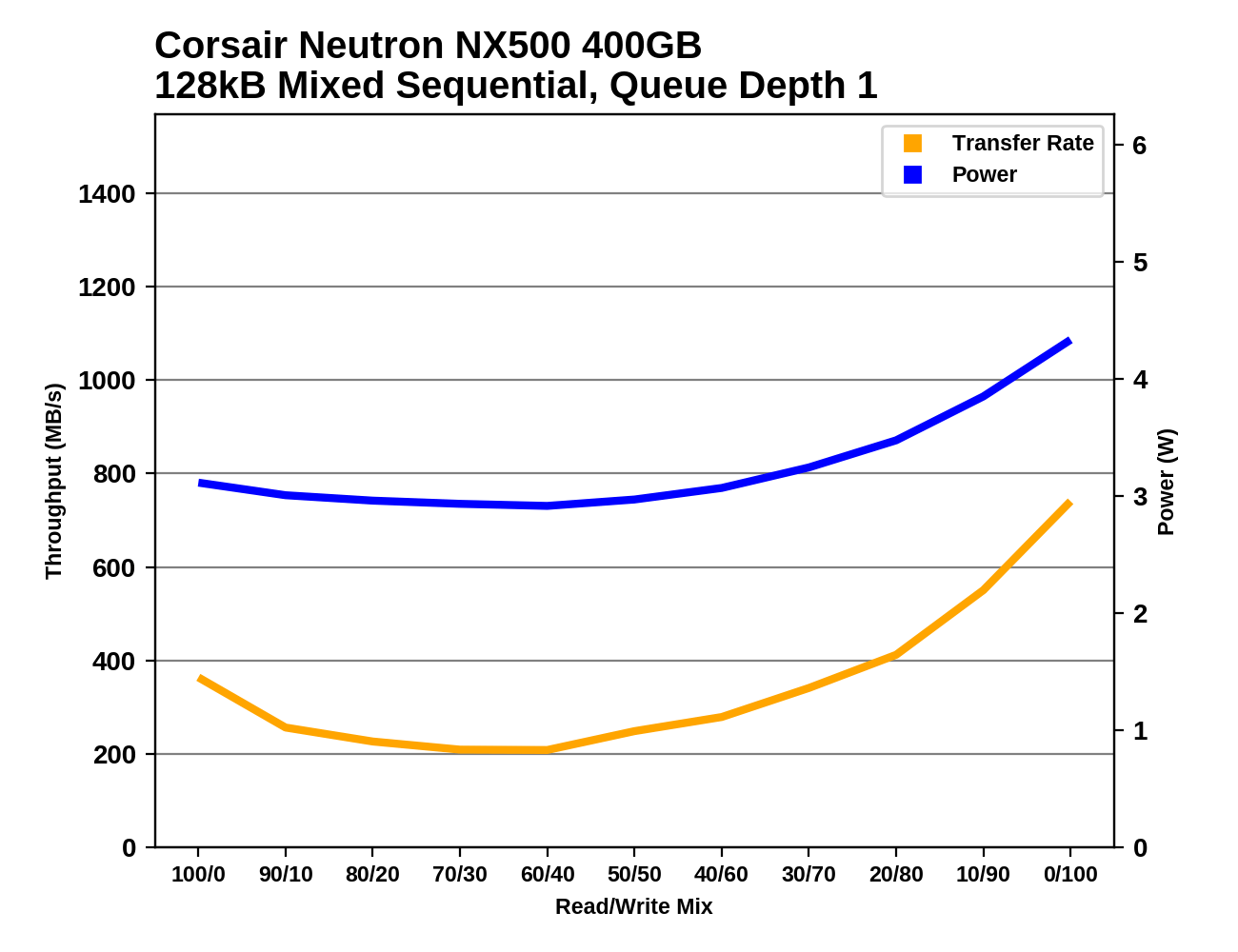The Corsair Neutron NX500 (400GB) PCIe SSD Review: Big Card, Big Pricetag
by Billy Tallis on August 16, 2017 10:00 AM ESTMixed Random Performance
Our test of mixed random reads and writes covers mixes varying from pure reads to pure writes at 10% increments. Each mix is tested for up to 1 minute or 32GB of data transferred. The test is conducted with a queue depth of 4, and is limited to a 64GB span of the drive. In between each mix, the drive is given idle time of up to one minute so that the overall duty cycle is 50%.

The QD4 mixed random I/O performance of the Corsair Neutron NX500 is pretty good overall, but the Patriot Hellfire has a clear advantage. The Zotac SONIX on the other hand can't beat the SATA-based Samsung 850 PRO and is only slightly faster than the Intel 600p.

The power efficiency of the NX500 during the mixed random I/O test is about average, while the faster Patriot Hellfire beating all the other planar NAND SSDs in this bunch.
 |
|||||||||
The performance of the Neutron NX500 increases gradually as the portion of writes increases, not dropping anywhere along the way but also not spiking very high in the final phase of the test where many drives improve greatly.
Mixed Sequential Performance
Our test of mixed sequential reads and writes differs from the mixed random I/O test by performing 128kB sequential accesses rather than 4kB accesses at random locations, and the sequential test is conducted at queue depth 1. The range of mixes tested is the same, and the timing and limits on data transfers are also the same as above.

The mixed sequential performance of the Corsair Neutron NX500 is poor, with it and the Patriot Hellfire performing slightly worse than the SATA-based Samsung 850 PRO and only beating the entry-level TLC NVMe drives. The Zotac SONIX on the other hand performed quite well, though still a bit slower than what the OCZ RD400A manages using the same NAND.

The power efficiency of the NX500 and Patriot Hellfire rank no better than their overall performance on the mixed sequential test, and the Zotac SONIX is only modestly better off.
 |
|||||||||
The NX500's performance on the mixed sequential test bottoms out with 70/30 and 60/40 read/write mixtures, but then shows good improvement as the proportion of writes continues to increase. Most of the MLC drives are able to avoid the performance drop that the NX500 suffers in the early phases of this test, which is what leads to the Zotac SONIX scoring so much better than the NX500.










45 Comments
View All Comments
Kristian Vättö - Wednesday, August 16, 2017 - link
There are numerous 8-lane enterprise SSDs already.hlm - Wednesday, August 16, 2017 - link
e.g. HGST FlashMAX III and HGST Ultrastar SN260 products are eight-lane devices.The_Assimilator - Wednesday, August 16, 2017 - link
Hey look, another SSD that has no reason whatsoever to exist!I don't understand why manufacturers don't, y'know, try to COMPETE with Samsung instead of re-re-releasing the same old, tired, slow controllers with slightly different but ultimately insignificant spins on them.
DanNeely - Wednesday, August 16, 2017 - link
Because unless you have a billion dollars to spend and a few years to wait, you can't create your own controller. That means almost all of the other companies selling drives have to pick and choose between a handful of controllers made by Phison/etc. Until they recover from Samsung's blind siding them and design new higher performing architectures from the ground up none of them have anything in the same performance class. If what happened at the start of the market when Intel's controllers were unbeatable is any indication we should hopefully have competitive designs available in another year or so.FunBunny2 - Wednesday, August 16, 2017 - link
-- Because unless you have a billion dollars to spend and a few years to wait, you can't create your own controller.well, isn't a controller an implementation of physics and math? which is to say, unless something new happens with NAND chips (not just node size or xLC), may haps we've reached the one-true-answer to the controller problem? may be there's just no more there, there.
Samus - Wednesday, August 16, 2017 - link
Wow. That was disappointing.RaistlinZ - Wednesday, August 16, 2017 - link
Current Newegg Prices:1. 500GB Samsung 960 Pro = $299.99
2. 1TB Samsung 960 Pro = 600.82
The NX500 has no reason to exist. The price needs to be cut in half to make it even REMOTELY attractive.
alpha754293 - Wednesday, August 16, 2017 - link
I'm surprised you didn't bother comparing it against the Intel 750 Series 400 GB PCIe NVMe SSD.Billy Tallis - Thursday, August 17, 2017 - link
I had originally planned to include the 400GB 750, but some of the results from it looked funny and I decided it wasn't worth postponing the review for several days to re-test the 750. That drive's a pain to test, because I have to run each test twice in order to record the power on both the 3.3V and 12V lines, and the performance has to match between the two runs for the results to be valid.alpha754293 - Friday, August 18, 2017 - link
Depending on how you want to tackle/handle it.There are statistical methods available out there that even with noisy data (e.g. high standard deviations) that you can still use it to process data that might otherwise not make sense at first glance, on the surface.
Course, that would also mean that care would need to be taking so that the tests in and of itself are repeatable.
I only mention it because I would be VERY interested to see how this compared to the Intel 750 series.
Thanks.